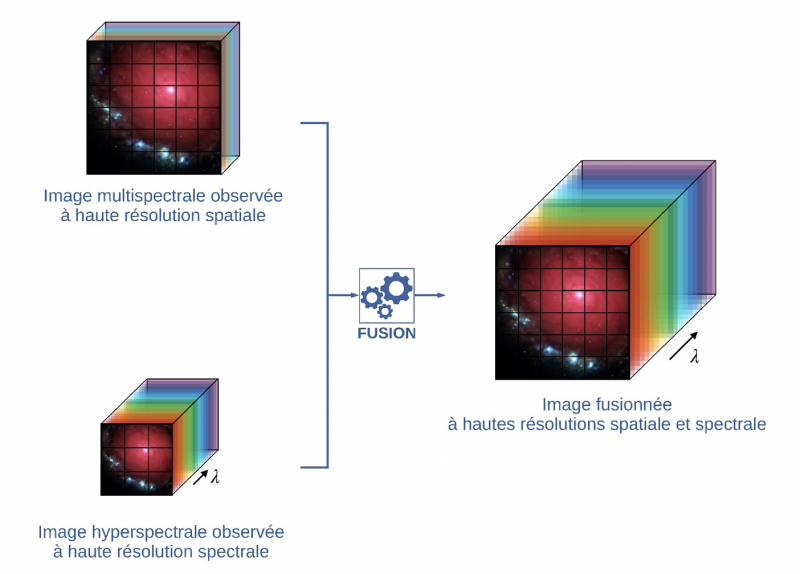How to combine images from space telescopes?
The data transmitted by probes and orbital telescopes must be processed to be used by scientists, and their sensors provide several types of images with different properties. Nicolas Dobigeon, a specialist in the fusion of these images at the Institut de Recherche en Informatique de Toulouse (IRIT – CNRS/Université Toulouse 3 Paul Sabatier/INP Toulouse), has been asked by the Toulouse research teams involved in the James-Webb space telescope. In the line of sight, the Orion nebula and its nursery of stars.
Launched into space on December 25, 2021, the James Webb Space Telescope (JWST) is the largest and most advanced observatory ever placed in orbit. Many research groups are involved in this international mission, from its design to the processing of data sent by the telescope, including several teams from Toulouse. The Signal and Communications team of IRIT, the researchers of the MICMAC group of IRAP, are notably involved in the priority scientific program PDRs4all.
“This project aims to study the birth of stars in the Orion nebula, a real nursery that will help us better understand the formation of stars,” explains Nicolas Dobigeon, professor at Toulouse INP and member of IRIT. “PDRs4all is led by Olivier Berné, a CNRS researcher at IRAP (1), who asked me for my expertise in signal processing and image fusion. The international PDRs4all project (2) brings together scientists from 19 countries and is one of the 13 priority programs of the James Webb Telescope. 40 hours of observations are dedicated to it, which is enough to provide prodigious amounts of raw data.
However, these images are generally not usable as they are, and different processes must be deployed so that researchers can use them, especially if we then wish to share these results and images with the general public. Nicolas Dobigeon is familiar with these issues since he has worked on remote sensing images which, although they were aimed at the Earth rather than the stars, are based on the same scientific principles.
Signal and image processing is a hybrid discipline, straddling applied mathematics, computer science and the field from which the data comes.
Nicolas Dobigeon, IRIT
“When you take a photograph with a conventional camera, you get an image from a mixture of three colors: red, green and blue (RGB),” explains Nicolas Dobigeon. In many application fields, such as Earth observation, biology or astronomy, spectro-imagers acquire hyperspectral images, also called multiband, composed of hundreds of basic colors. They must be processed to extract the vast amount of information they contain.“
The advanced hardware aboard telescopes like JWST is highly specialized and relies on different sensors, so you get hyperspectral images with low spatial resolution on the one hand, and multispectral images composed of fewer colors but with much better spatial resolution on the other. The fusion consists in combining them into a single image that retains the advantages of both. This is how huge and beautiful photographs of our planet are made.

The algorithms I developed to merge Earth observation images can be adapted to process astrophysical data provided by JWST.
Nicolas Dobigeon, IRIT
For the past eight years, Nicolas Dobigeon has been designing fast, efficient and inexpensive fusion methods based on an inverse formulation of the problem. Our specificity comes from the idea of exploiting the complementary characteristics of sensors,” explains the researcher from Toulouse. We describe mathematically the acquisition processes of the sensors, which introduce degradations. We then try to reverse these processes to mitigate their effects. We can then overcome the difficulties associated with the poor spatial resolution of hyperspectral images.”
Observations of PDRs4all have not yet begun, but the researchers have successfully conducted tests on artificial images mimicking those that JWST will provide, also standing by while waiting for their turn.
Notes
- Institut de Recherche en Astrophysique et Planétologie (IRAP – CNRS/CNES/Université Toulouse 3 Paul Sabatier).
- In addition to IRAP and IRIT, a third research institute in Toulouse is involved: the Laboratory of Quantum Chemistry and Physics (LCPQ – CNRS/Université Toulouse 3 Paul Sabatier).
Further Resources
- Scientific articles :
- C. Guilloteau, Th. Oberlin, O. Berné, É. Habart and N. Dobigeon. Simulated JWST datasets for multispectral and hyperspectral image fusion. The Astronomical Journal, vol. 160, no. 1, June 2020.
- C. Guilloteau, Th. Oberlin, O. Berné and N. Dobigeon. Hyperspectral and multispectral image fusion under spectrally varying spatial blurs – Application to high dimensional infrared astronomical imaging. IEEE Trans. Computational Imaging, vol. 6, pp. 1362-1374, Sept. 2020.
- IRAP Press Release
IRAP Contacts
- Claire Guilloteau, claire.guilloteau@irap.omp.eu
- Olivier Berné, olivier.berne@irap.omp.eu






